Cooling of Heated Blocks with Triangular Guide Protrusions Simulating Printed Circuit Boards
Abstract
1. Introduction
2. Materials and Methods
2.1. Geometrical Model, Computational Domain, and Boundary Conditions
2.2. Mathematical Model and Numerical Procedure
2.3. Mesh Independency and Validation Study
3. Results and Discussion
3.1. Fluid Flow Characteristics
3.2. Effects of Channel Height on Flow Structures
3.3. Effects of Inlet Velocity (Reynolds Number) on Flow Structures
3.4. Heat Transfer Characteristics
4. Conclusions and Future Work
Author Contributions
Funding
Institutional Review Board Statement
Informed Consent Statement
Data Availability Statement
Acknowledgments
Conflicts of Interest
Nomenclature
| cp | constant pressure specific heat, J/kgK |
| Dh | hydraulic diameter of the channel, m |
| ER | expansion ratio |
| H | channel height, m |
| h | step height or heat transfer coefficient, m or W/m2K |
| IC | integrated circuit |
| k | thermal conductivity, W/mK |
| L | channel length, m |
| l | block length, m |
| Nu | Nusselt number |
| P | pressure, Pa |
| PCB | Printed circuit board |
| Re | Reynolds number |
| RL | reattachment length, m |
| s | distance between blocks, m |
| T | temperature, °C or K |
| u | x-component of velocity, m/s |
| x | axial distance, m |
| v | y-component of velocity, m/s |
| y | vertical distance, m |
| Greek symbols | |
| α | incident angle of fluid from protrusions to upper surface of blocks, ° |
| ρ | density, kg/m3 |
| ν | kinematic viscosity, m2/s |
| Subscript | |
| ave | average |
| i | inlet |
| n | for the nth block |
| o | free stream or outlet |
| s | surface |
References
- Hannemann, R. Thermal control for mini- and microcomputers: The limits of air cooling. Bull. Int. Cent. Heat Mass Transf. 1989, 3, 65–83. [Google Scholar]
- Bergles, A.E. Evolution of cooling technology for electrical, electronic, and microelectronic equipment. Heat Transf. Eng. 1986, 7, 97–105. [Google Scholar] [CrossRef]
- Sathe, S.; Sammakia, B. A review of recent developments in some practical aspects of air-cooled electronic packages. ASME J. Heat Transf. 1998, 120, 830–839. [Google Scholar] [CrossRef]
- Kim, S.J.; Kim, D. Forced convection in microstructures for electronic equipment cooling. ASME J. Heat Transf. 1999, 121, 639–645. [Google Scholar] [CrossRef]
- Webb, R.L. Next generation devices for electronic cooling with heat rejection to air. ASME J. Heat Transf. 2005, 127, 2–10. [Google Scholar] [CrossRef]
- Guo, Z.Y.; Li, D.Y.; Wang, B.X. A novel concept for convective heat transfer enhancement. Int. J. Heat Mass Transf. 1998, 41, 2221–2225. [Google Scholar] [CrossRef]
- Bergles, A.E. Recent developments in enhanced heat transfer. Heat Mass Transf. 2011, 47, 1001–1008. [Google Scholar] [CrossRef]
- Christensen, A.; Graham, S. Thermal Effects in Packaging High Power Light Emitting Diode Arrays. Appl. Therm. Eng. 2009, 29, 364–371. [Google Scholar] [CrossRef]
- Culham, J.R.; Khan, W.A.; Yovanovich, M.M.; Muzychka, Y.S. The Influence of Material Properties and Spreading Resistance in the Thermal Design of Plate Fin Heat Sinks. Trans. ASME J. Electron. Packag. 2007, 129, 76–81. [Google Scholar] [CrossRef]
- Almuhtady, A.; Alhazmi, M.; Al-Kouz, W.; Raizah, Z.A.S.; Ahmed, S.E. Entropy Generation and MHD Convection within an Inclined Trapezoidal Heated by Triangular Fin and Filled by a Variable Porous Media. Appl. Sci. 2021, 11, 1951. [Google Scholar] [CrossRef]
- Das, R. A Simplex Search Method for a Conductive-Convective Fin with Variable Conductivity. Int. J. Heat Mass Transf. 2011, 54, 5001–5009. [Google Scholar] [CrossRef]
- Mallick, A.; Das, R. Application of Simplex Search Method for Predicting Unknown Parameters in an Annular Fin Subjected to Thermal Stresses. J. Therm. Stress. 2014, 37, 236–251. [Google Scholar] [CrossRef]
- Deshamukhya, T.; Bhanja, D.; Nath, S. Heat Transfer Enhancement Through Porous Fins: A Comprehensive Review of Recent Developments and Innovations. Proc. Inst. Mech. Eng. Part C J. Mech. Eng. Sci. 2021, 235, 946–960. [Google Scholar] [CrossRef]
- Karabulut, K. Heat Transfer Improvement Study of Electronic Component Surfaces Using Air Jet Impingement. J. Comput. Electron. 2019, 18, 1259–1271. [Google Scholar] [CrossRef]
- Karabulut, K.; Alnak, D.E. Study of Cooling of the Varied Designed Warmed Surfaces with and Air Jet Impingement. Pamukkale Univ. J. Eng. Sci. 2020, 26, 88–98. [Google Scholar] [CrossRef]
- Takeishi, K.-I.; Krewinkel, R.; Oda, Y.; Ichikawa, Y. Heat Transfer Enhancement of Impingement Cooling by Adopting Circular-Ribs or Vortex Generators in the Wall Jet Region of a Round Impingement Jet. Int. J. Turbomach. Propuls. Power 2020, 5, 17. [Google Scholar] [CrossRef]
- Ren, Z.; Yang, X.; Lu, X.; Li, X.; Ren, J. Experimental Investigation of Micro Cooling Units on Impingement Jet Array Flow Pressure Loss and Heat Transfer Characteristics. Energies 2021, 14, 4757. [Google Scholar] [CrossRef]
- Alnak, D.E.; Koca, F.; Alnak, Y.A. Numerical Investigation of Heat Transfer from Heated Surfaces of Different Shapes. J. Eng. Thermophys. 2021, 30, 494–507. [Google Scholar] [CrossRef]
- Koca, F. Numerical Investigation of Corrugated Channel with Backward-Facing Step in Terms of Fluid Flow and Heat Transfer. J. Eng. Thermophys. 2022, 31, 187–199. [Google Scholar] [CrossRef]
- Nazir, U.; Sohail, M.; Selim, M.M.; Alrabaiah, H.; Kumam, P. Finite Element Simulations of Hybrid Nano-Carreau Yasuda Fluid with Hall and Ion Slip Forces over Rotating Heated Porous Cone. Sci. Rep. 2021, 11, 19604. [Google Scholar] [CrossRef]
- Naseem, T.; Nazir, U.; Sohail, M.; Alrabaiah, H.; Sherif, E.-S.M.; Park, C. Numerical exploration of thermal transport in water-based nanoparticles: A computational strategy. Case Stud. Therm. Eng. 2021, 27, 101334. [Google Scholar] [CrossRef]
- Wang, F.; Nazir, U.; Sohail, M.; El-Zahar, E.R.; Park, C.; Thounthong, P. A Galerkin Strategy for Tri-Hybridized Mixture in Ethylene Glycol Comprising Variable Diffusion and Thermal Conductivity Using Non-Fourier’s Theory. Nanotechnol. Rev. 2022, 11, 834–845. [Google Scholar] [CrossRef]
- Algehyne, E.A.; El-Zahar, E.R.; Elhag, S.H.; Bayones, F.S.; Nazir, U.; Sohail, M.; Kumam, P. Investigation of Thermal Performance of Maxwell Hybrid Nanofuid Boundary Value Problem in Vertical Porous Surface via Finite Element Approach. Sci. Rep. 2022, 12, 2335. [Google Scholar] [CrossRef] [PubMed]
- Medjahed, D.M.; Ameur, H.; Rebhi, R.; Inc, M.; Ahmad, H.; Menni, Y.; Lorenzini, G.; Bayones, F.S.; Aldhabani, M. Details on the Hydrothermal Characteristics within a Solar-Channel Heat-Exchanger Provided with Staggered T-Shaped Baffles. Energies 2021, 14, 6698. [Google Scholar] [CrossRef]
- Zargar, A.; Tarokh, A.; Hemmati, A. The Steady Wake of a Wall-Mounted Rectangular Prism with a Large-Depth-Ratio at Low Reynolds Numbers. Energies 2021, 14, 3579. [Google Scholar] [CrossRef]
- Myrum, T.A.; Acharya, S.; Sinha, S.; Qui, X. The effect of placing vortex generators above ribs in ribbed ducts on the flow, flow temperature, and heat transfer behavior. ASME J. Heat Transf. 1996, 118, 294–300. [Google Scholar] [CrossRef]
- Wu, H.-W.; Wang, S.-W.; Perng, S.-W. The effective installation of an inclined plate for the enhancement of forced convection over rectangular sources. Heat Mass Transf. 1998, 33, 431–438. [Google Scholar] [CrossRef]
- Yoo, S.-Y.; Park, J.-H.; Chung, M.-H. Local heat transfer characteristics in simulated electronic modules. ASME J. Electron. Packag. 2003, 125, 362–368. [Google Scholar] [CrossRef]
- Fu, W.-S.; Tong, B.-H. Numerical investigation of heat transfer characteristics of the heated blocs in the channel with a transversely oscillating cylinder. Int. J. Heat Mass Transf. 2004, 47, 341–351. [Google Scholar] [CrossRef]
- Korichi, A.; Oufer, L. Numerical heat transfer in a rectangular channel with mounted obstacles on upper and lower walls. Int. J. Therm. Sci. 2005, 44, 644–655. [Google Scholar] [CrossRef]
- Wu, H.-W.; Perng, S.-W. Turbulent flow and heat transfer enhancement of mixed convection over heated blocks in a channel. Int. J. Numer. Methods Heat Fluid Flow 2005, 15, 205–225. [Google Scholar] [CrossRef]
- Alawadhi, E.M. Forced convection cooling enhancement for rectangular blocks using a wavy plate. IEEE Trans. Compon. Packag. Technol. 2005, 28, 525–533. [Google Scholar] [CrossRef]
- Icoz, T.; Jaluria, Y. Design optimization of size and geometry of vortex promoter in a two-dimensional channel. ASME J. Heat Transf. 2006, 128, 1081–1092. [Google Scholar] [CrossRef]
- Oztop, H.F.; Varol, Y.; Alnak, D.E. Control of heat transfer and fluid flow using a triangular bar in heated blocks located in a channel. Int. Comm. Heat Mass Transf. 2009, 36, 878–885. [Google Scholar] [CrossRef]
- Davalath, J.; Beyazıtoglu, Y. Forced convection cooling across rectangular blocks. ASME J. Heat Transf. 1987, 109, 321–328. [Google Scholar] [CrossRef]
- Moussaoui, M.A.; Jami, M.; Mezrhab, A.; Naji, H. Lattice Boltzmann Simulation of Convective Heat Transfer from Heated Blocks in a Horizontal Channel. Numer. Heat Transf. Part A 2009, 56, 422–443. [Google Scholar] [CrossRef]
- Kim, S.H.; Anand, N.K. Use of Slots to Enhance Forced Convective Cooling Between Channels with Surface Mounted Heat Sources. Numer. Heat Transf. Part A 2000, 38, 1–21. [Google Scholar]
- Yu, D.; Ameel, T.A.; Warrington, R.O.; Barron, R.F. Conjugate Heat Transfer with Buoyancy Effects from Micro-Chip Sized Repeated Heaters. ASME J. Electron. Packag. 1997, 119, 275–280. [Google Scholar] [CrossRef]
- Rizk, T.A.; Kleinstreuer, C. Forced-Convection Cooling of a Linear Array of Blocks in Open and Porous Matrix Channels. Heat Transf. Eng. 1991, 12, 40–47. [Google Scholar] [CrossRef]
- Sparrow, E.M.; Niethammer, J.E.; Chaboki, A. Heat Transfer and Pressure Drop Characteristics of Arrays of Rectangular Modules Encountered in Electronic Equipment. Int. J. Heat Mass Transf. 1982, 25, 961–973. [Google Scholar] [CrossRef]
- Chen, S.; Liu, Y.; Chan, S.F.; Leung, C.W.; Chan, T.L. Experimental Study of Optimum Spacing Problem in the Cooling of Simulated Electronic Package. Heat Mass Transf. 2001, 37, 251–257. [Google Scholar] [CrossRef]
- Alawadhi, E.M. Thermal analysis of a channel containing multiple heated obstacles with localized heat generations. IEEE Trans. Compon. Packag. Technol. 2004, 27, 327–336. [Google Scholar] [CrossRef]
- Malamataris, N.A.; Löhner, R. The computation of the eddy along the upper Wall in the three-dimensional flow over a backward-facing step. Int. J. Numer. Methods Fluids 2012, 68, 1102–1125. [Google Scholar] [CrossRef]
- Mahapatro, S.R.; Prakash, K.A. Three-dimensional study of multiple-jet cross flow cooling system with single array of heat sources. Heat Transf. Eng. 2018, 39, 252–267. [Google Scholar] [CrossRef]
- Tsay, Y.-L.; Cheng, J.-C. Enhancement of Heat Transfer from Block Heat Sources Mounted on a Short Board to Air Stream in a Channel by Constructing Slots in the Board. Numer. Heat Transf. Part A 2006, 49, 495–510. [Google Scholar] [CrossRef]
- Cengel, Y.A.; Ghajar, A.J. Heat and Mass Transfer: Fundamentals and Applications, 5th ed.; McGraw Hill Education: New York, NY, USA, 2015. [Google Scholar]
- Schnipke, R.J.; Rice, J.G. Application of a new finite element method to convection heat transfer. In Proceedings of the Fourth International Conference on Numerical Methods in Thermal Problems, Swansea, UK, 15–18 July 1985. [Google Scholar]
- Nakamura, H.; Igarashi, T. Forced convection heat transfer from a low-profile block simulating a package of electronic equipment. ASME J. Heat Transf. 2004, 126, 463–470. [Google Scholar] [CrossRef]
- Kim, S.Y.; Sung, H.J.; Hyun, J.M. Mixed convection from multiple-layered boards with cross-streamwise periodic boundary conditions. Int. J. Heat Mass Transf. 1992, 35, 2941–2952. [Google Scholar]
- Asako, Y.; Yamaguchi, Y.; Faghri, M. Numerical and Experimental Prediction of Transitional Characteristics of Flow and Heat Transfer in an Array of Heated Blocks. ASME J. Electron. Packag. 1999, 199, 202–208. [Google Scholar] [CrossRef]
- Garimella, S.V.; Eibeck, P.A. Heat Transfer Characteristics of an Array of Protruding Elements in Single Phase Forced Convection. Int. J. Heat Mass Transf. 1990, 33, 2659–2669. [Google Scholar] [CrossRef]
- Tang, W.; Ghajar, A.J. Experimental Study of Conjugate Heat Transfer in a Horizontal Channel with Discrete Heated Cubic Blocks. In Proceedings of the ASME 32nd National Heat Transfer Conference, Baltimore, MD, USA, 8–12 August 1997; Volume 5. [Google Scholar]
- Mori, Y.S.; Hishida, K.; Maeda, M. Buoyancy effects on the wake behind a heated obstacle immersed in a turbulent boundary layer. Int. J. Heat Fluid Flow 1995, 16, 405–416. [Google Scholar] [CrossRef]
- Matsubara, K. Combined convection heat transfer in a channel with two ribs attached to one Wall. Heat Transf. Asian Res. 1999, 28, 379–394. [Google Scholar] [CrossRef]
- Nakajima, M.; Yanaoka, H.; Yoshikawa, H.; Ota, T. Numerical simulation of three-dimensional separated flow and heat transfer around staggered surface-mounted rectangular blocks in a channel. Numer. Heat Transf. Part A 2005, 47, 691–708. [Google Scholar] [CrossRef]
- Kitoh, A.; Sugawara, K.; Yoshikawa, H.; Ota, T. Expansion ratio effects on three-dimensional separated flow and heat transfer around backward-facing steps. ASME J. Heat Transf. 2007, 129, 1141–1155. [Google Scholar] [CrossRef]
- Jubran, B.A.; Al-Haroun, M.S. Heat Transfer Enhancement in Electronic Modules Using Various Secondary Air Injection Hole Arrangements. ASME J. Heat Transf. 1998, 120, 342–347. [Google Scholar] [CrossRef]
- Sultan, G.I. Enhancing Forced Convection Heat Transfer from Multiple Protruding Heat Sources Simulating Electronic Components in a Horizontal Channel by Passive Cooling. Microelectron. J. 2000, 31, 773–779. [Google Scholar] [CrossRef]
- Chen, Y.T.; Nie, J.H.; Armaly, B.F.; Hsieh, H.T. Turbulent Separated Convection Flow Adjacent to Backward-Facing Step-Effects of Step Height. Int. J. Heat Mass Transf. 2006, 49, 3670–3680. [Google Scholar] [CrossRef]
- Chen, l.; Asai, K.; Nonomura, T.; Xi, G.; Liu, T. A review of backward-facing step (BFS) flow mechanisms, heat transfer and control. Therm. Sci. Eng. Prog. 2018, 6, 194–216. [Google Scholar] [CrossRef]
- Thangam, S.; Knight, D.D. Effect of stepheight on the sparated flow past a backward facing step. Phys. Fluids A 1989, 1, 604–606. [Google Scholar] [CrossRef]
- Erturk, E. Numerical solutions of 2-D steady incompressible flow over a backward-facing step Part I: High Reynolds number solutions. Comput. Fluids 2008, 37, 633–655. [Google Scholar] [CrossRef]
- Armaly, B.F.; Durst, F.; Pereira, J.C.F.; Schönung, B. Experimental and theoretical investigation of backward-facing step flow. J. Fluid Mech. 1983, 127, 473–496. [Google Scholar] [CrossRef]
- Chen, C.-K.; Wong, K.-L. Finite Element Solutions for Laminar Flow and Combined Convection Around a Square Prism. Warme-Und Stoffubertrag. 1988, 22, 61–67. [Google Scholar] [CrossRef]
- Igarashi, T.; Takasaki, H. Fluid Flow and Heat Transfer Around a Rectangular Block Fixed on a Flat-Plate Laminar Boundary Layer. In ASME/JSME Thermal Engineering; Fletcher, L.S., Aihara, T., Eds.; Book No. H0933A; ASME: New York, NY, USA, 1995. [Google Scholar]
- Young, T.J.; Vafai, K. Convective Cooling of a Heated Obstacle in a Channel. Int. J. Heat Mass Transf. 1998, 41, 3131–3148. [Google Scholar] [CrossRef]
- Leung, C.W.; Chen, S.; Chan, T.L. Numerical Simulation of Laminar Forced Convection in an Air-Cooled Horizontal Printed Circuit Board Assembly. Numer. Heat Transf. Part A 2000, 37, 373–393. [Google Scholar]
- Meinders, E.R.; Van Der Meer, T.H.; HanJalic, K. Local Convective Heat Transfer from an Array of Wall-Mounted Cubes. Int. J. Heat Mass Transf. 1998, 41, 335–346. [Google Scholar] [CrossRef]
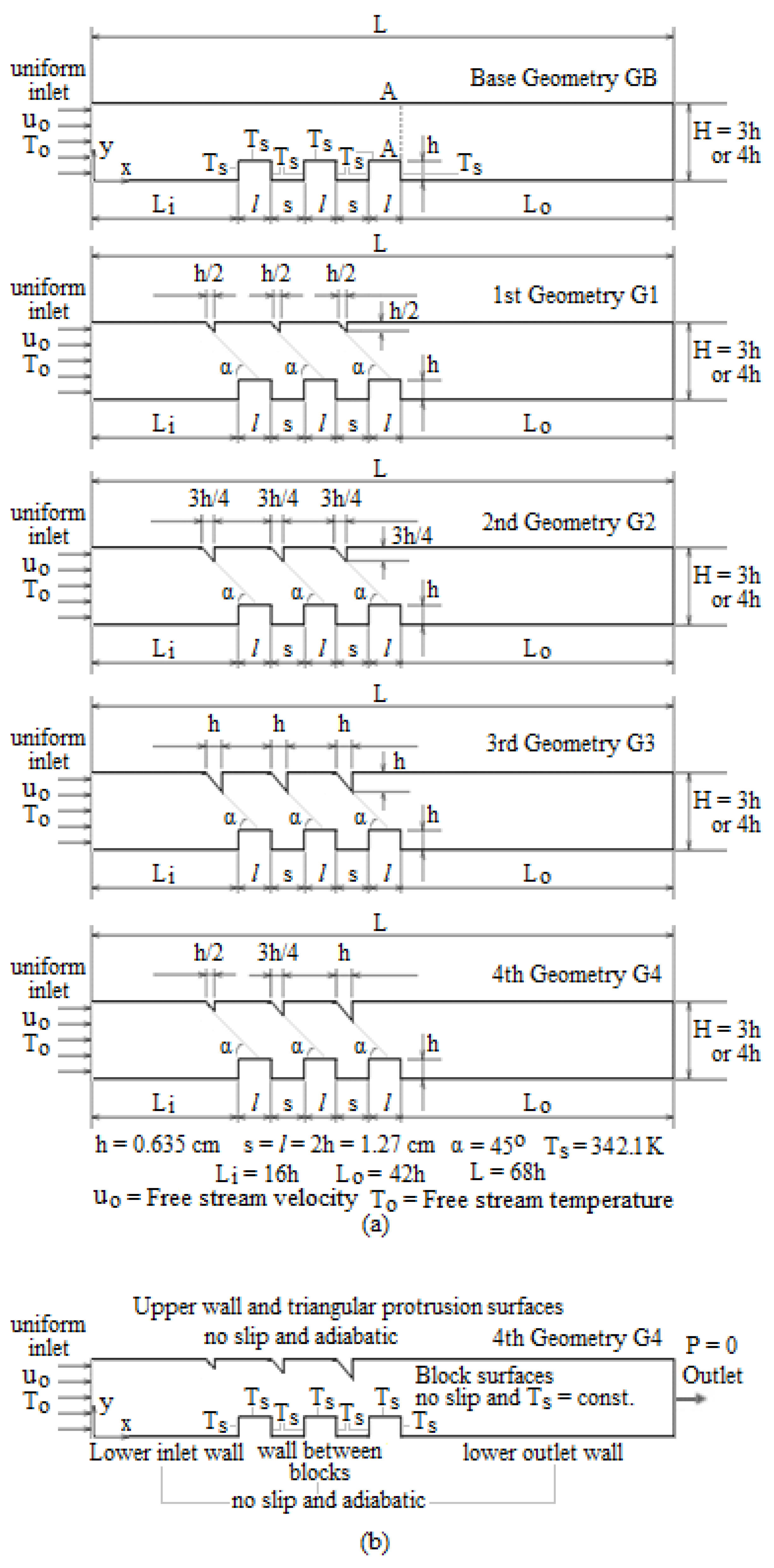
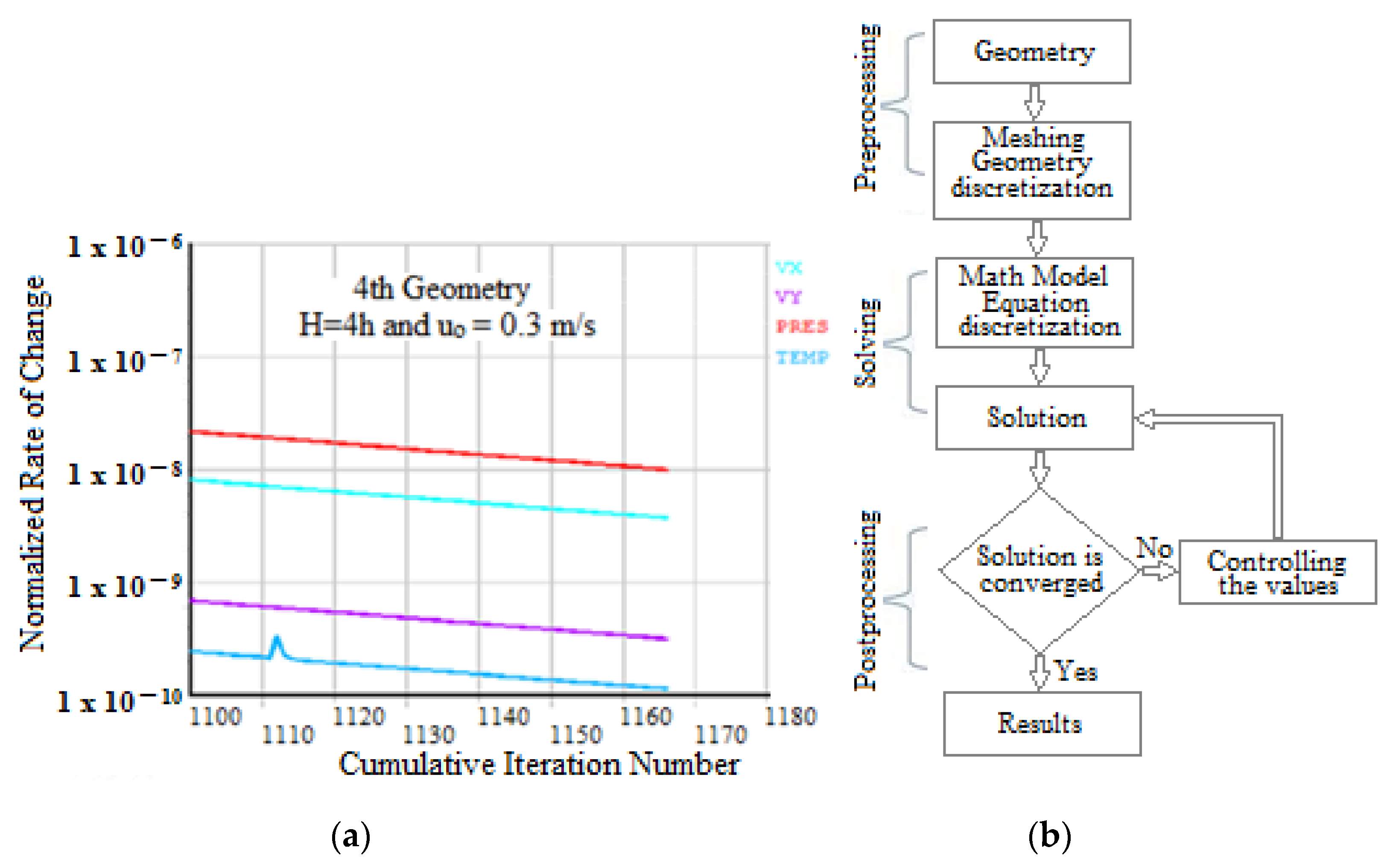
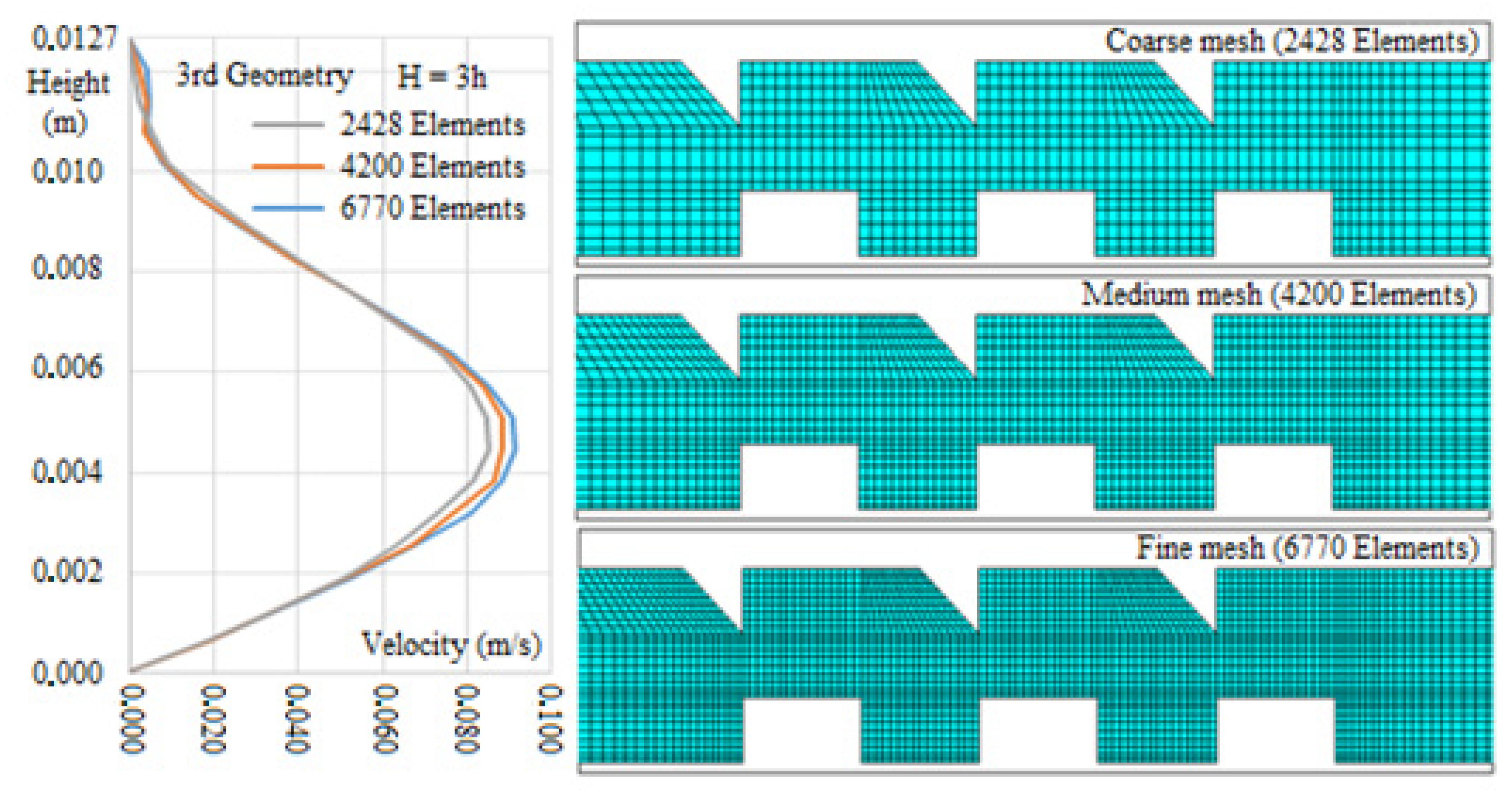



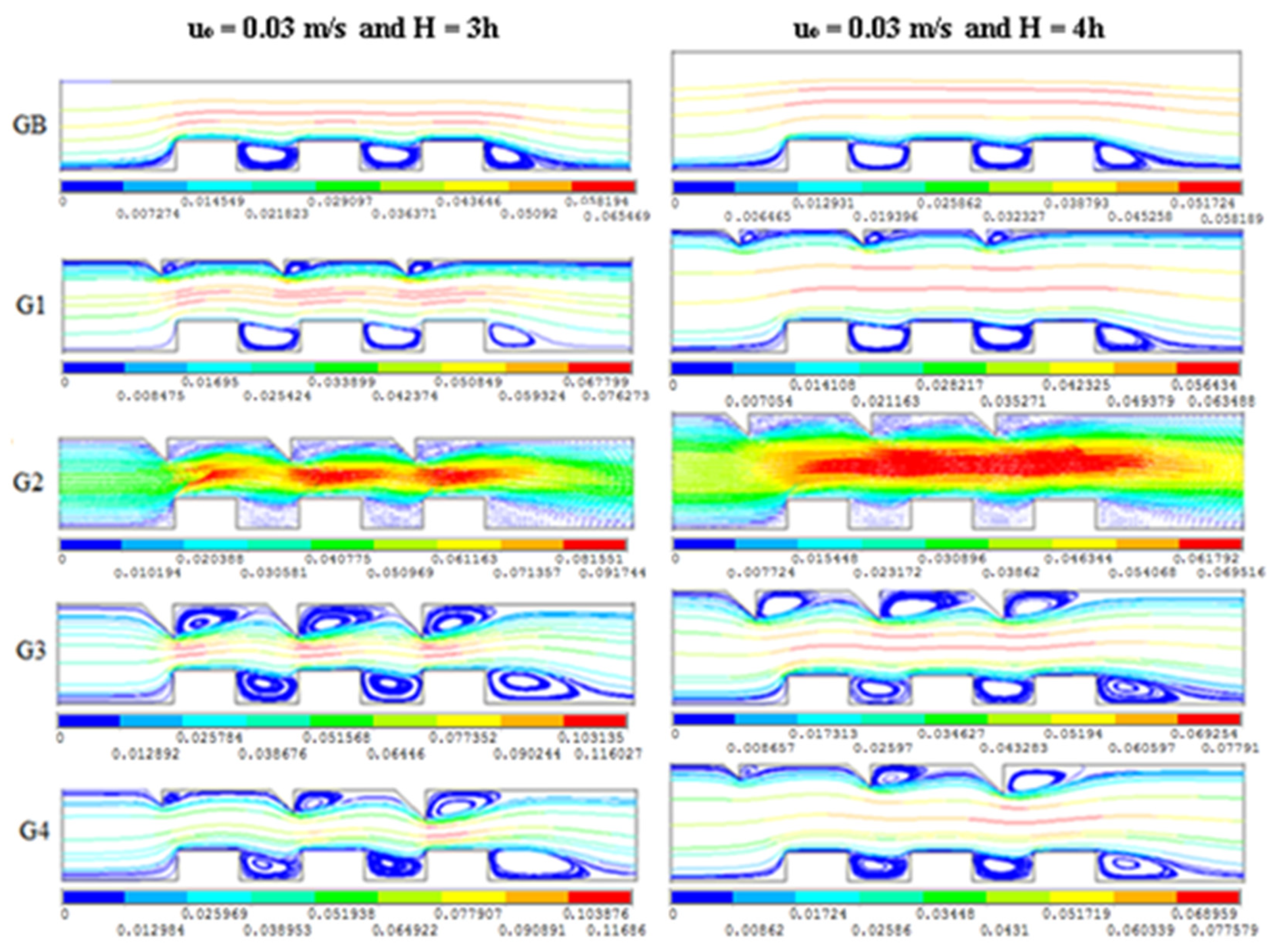
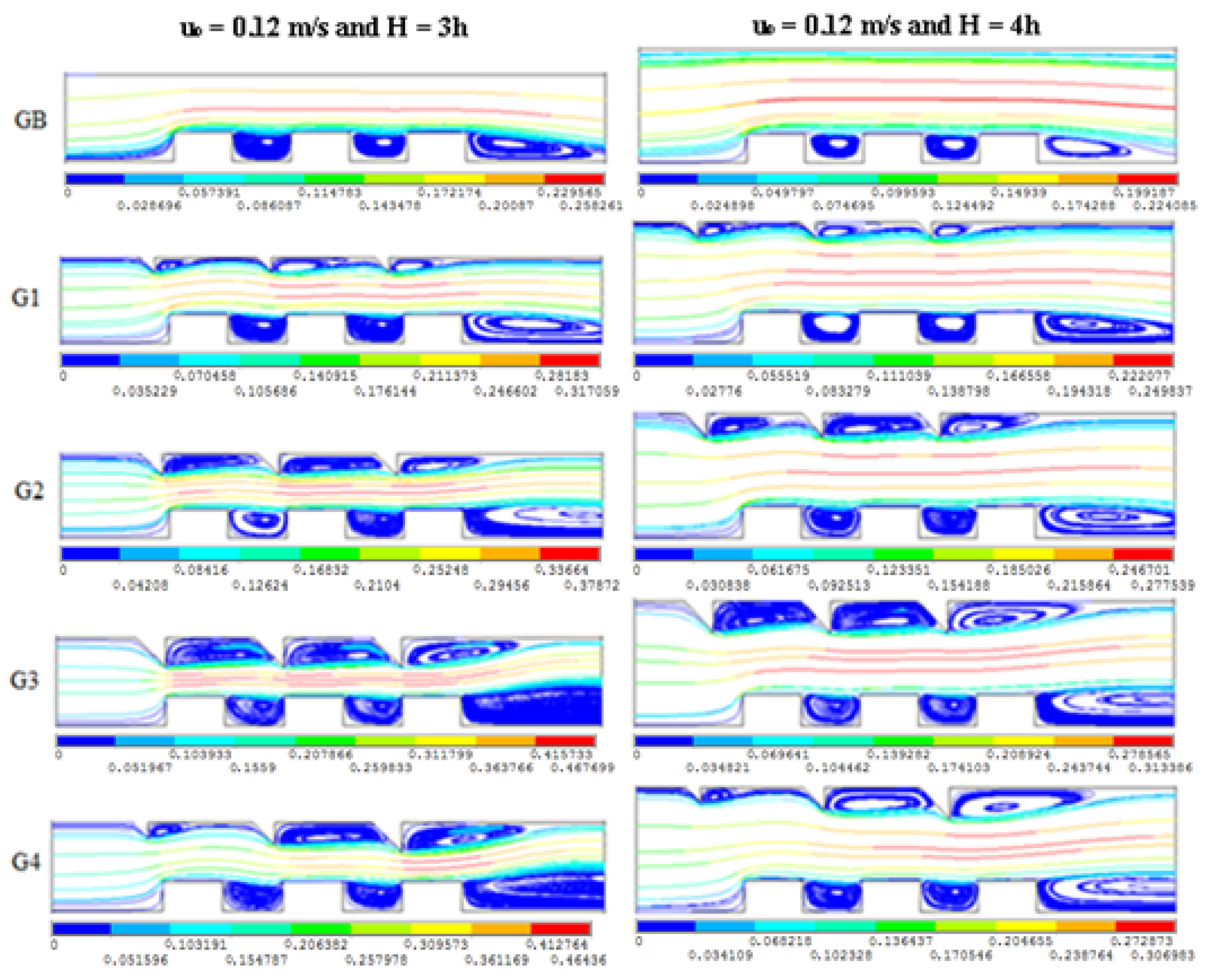


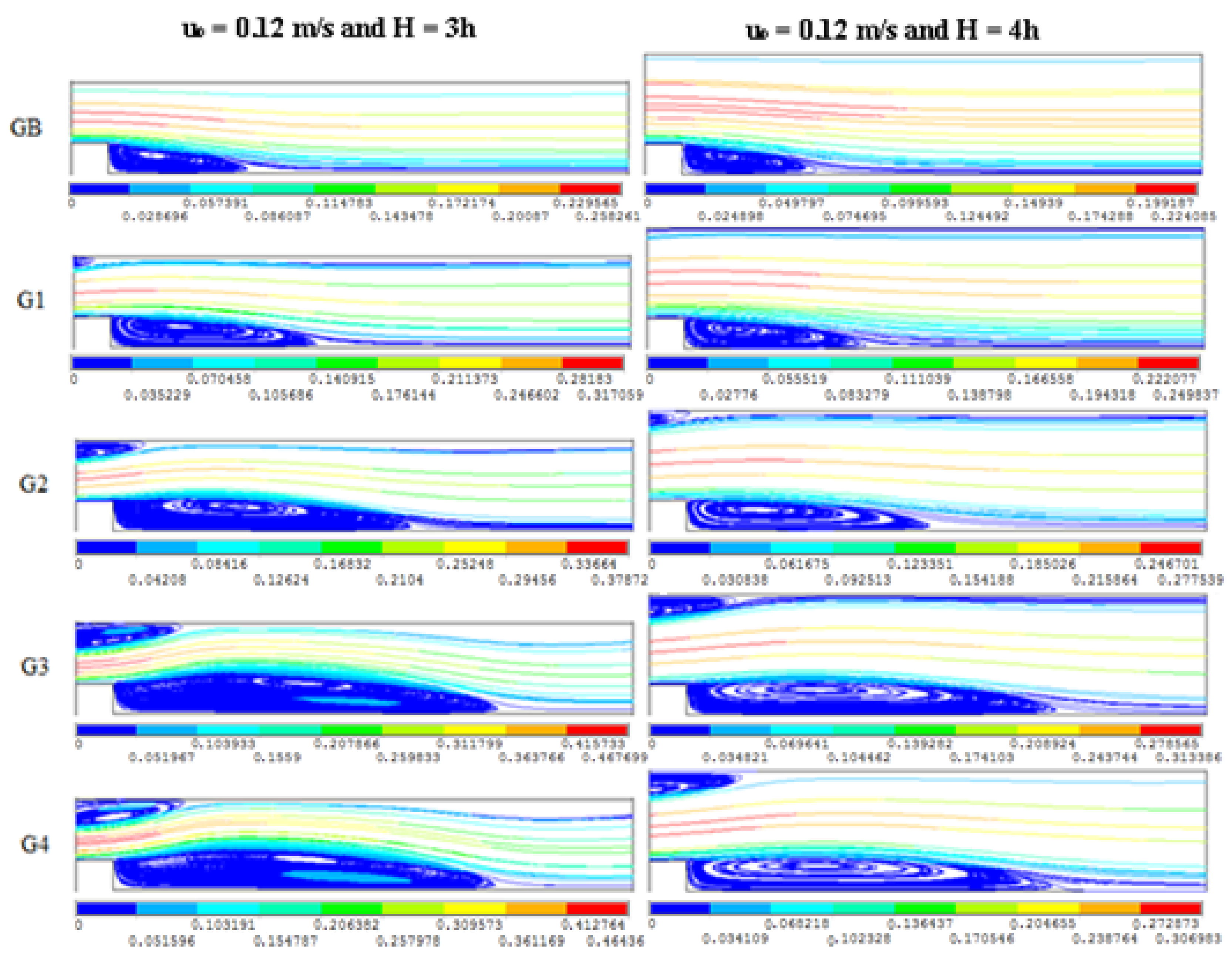
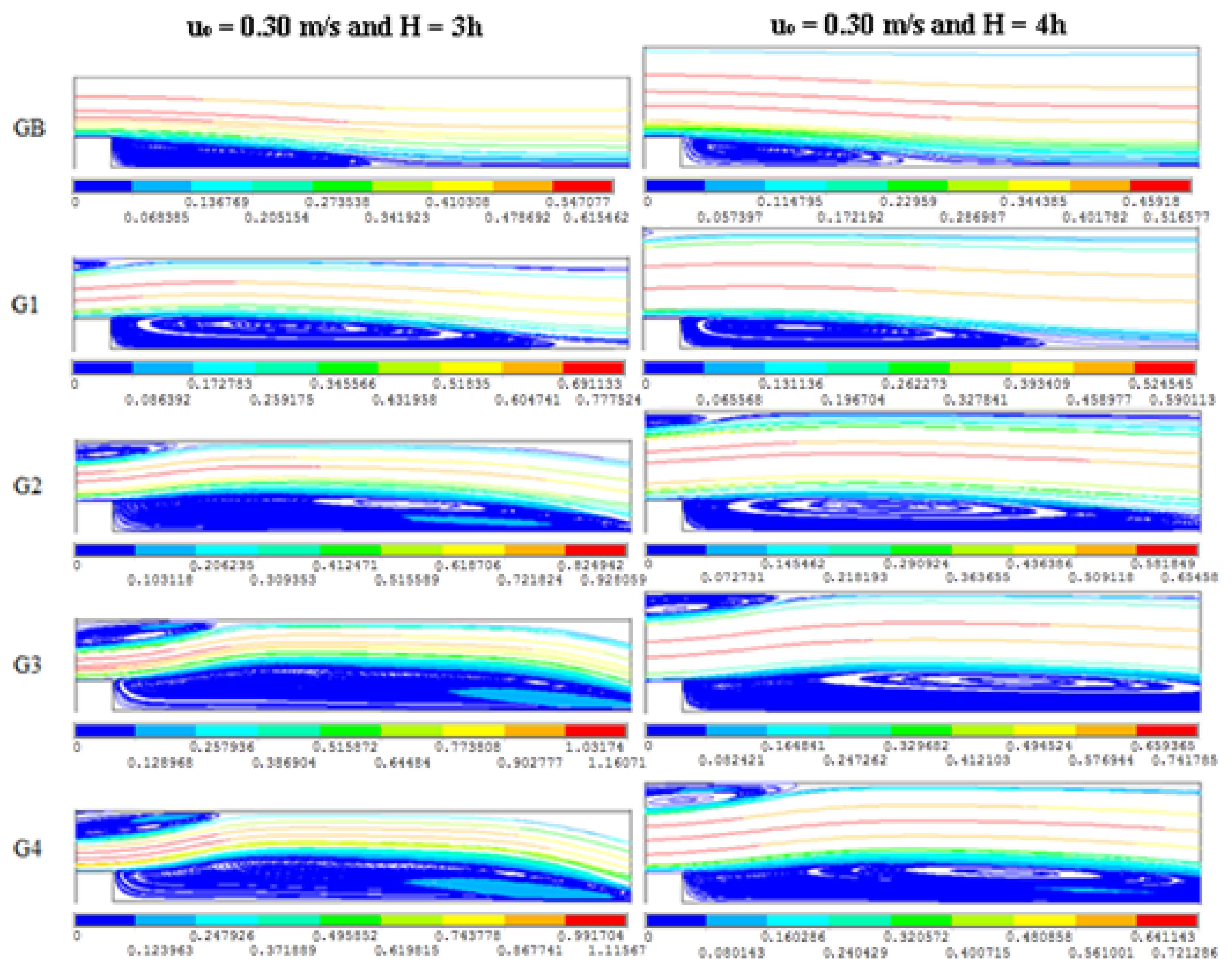
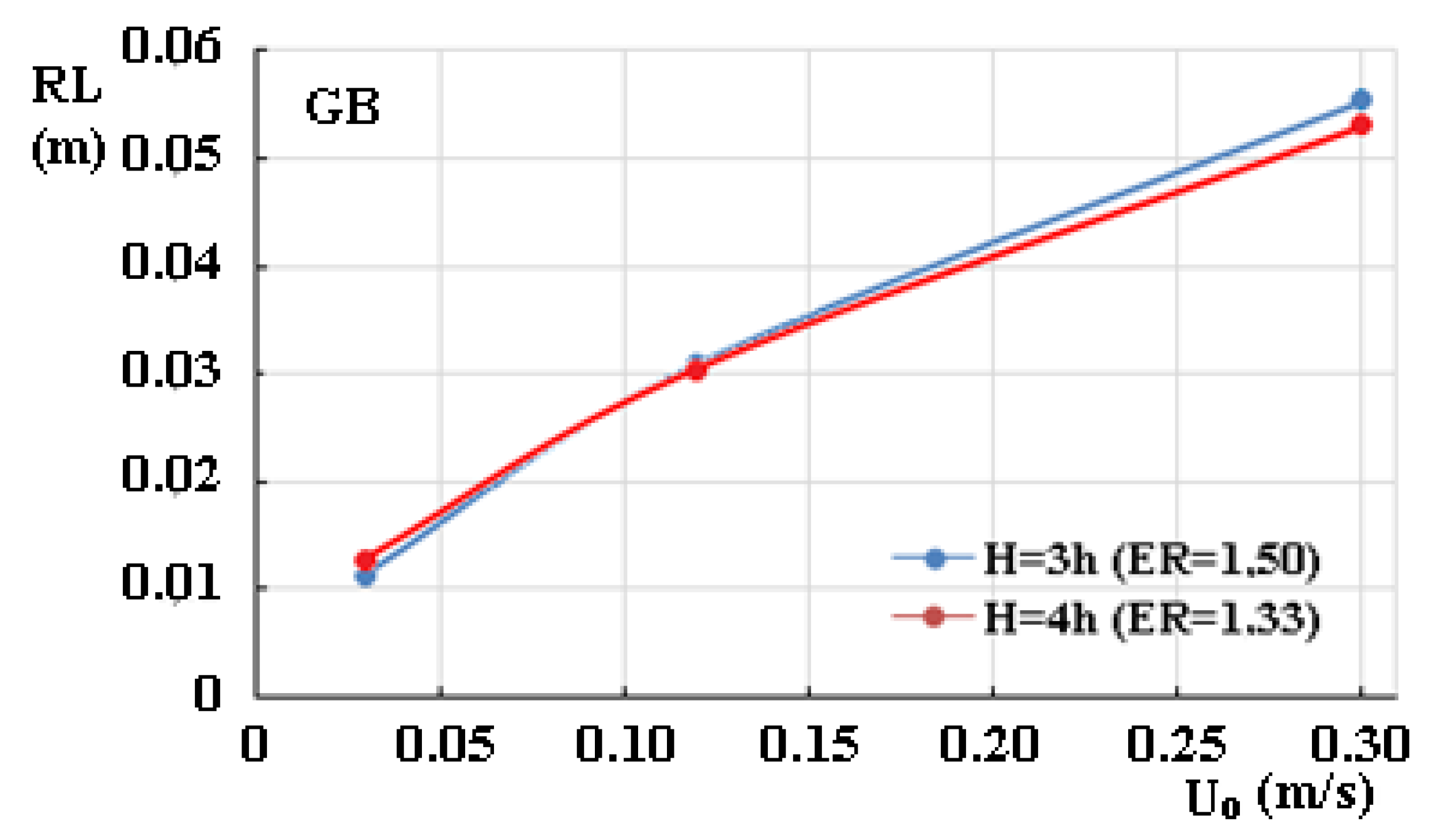
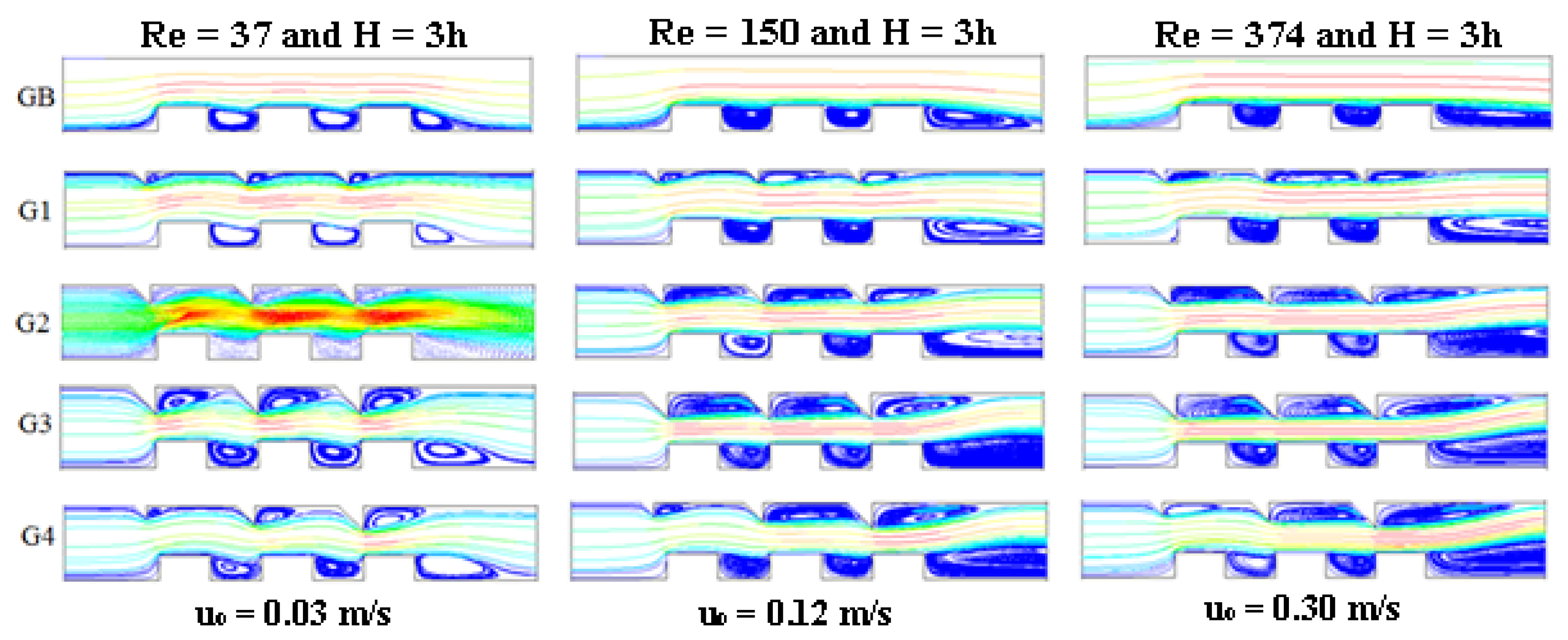


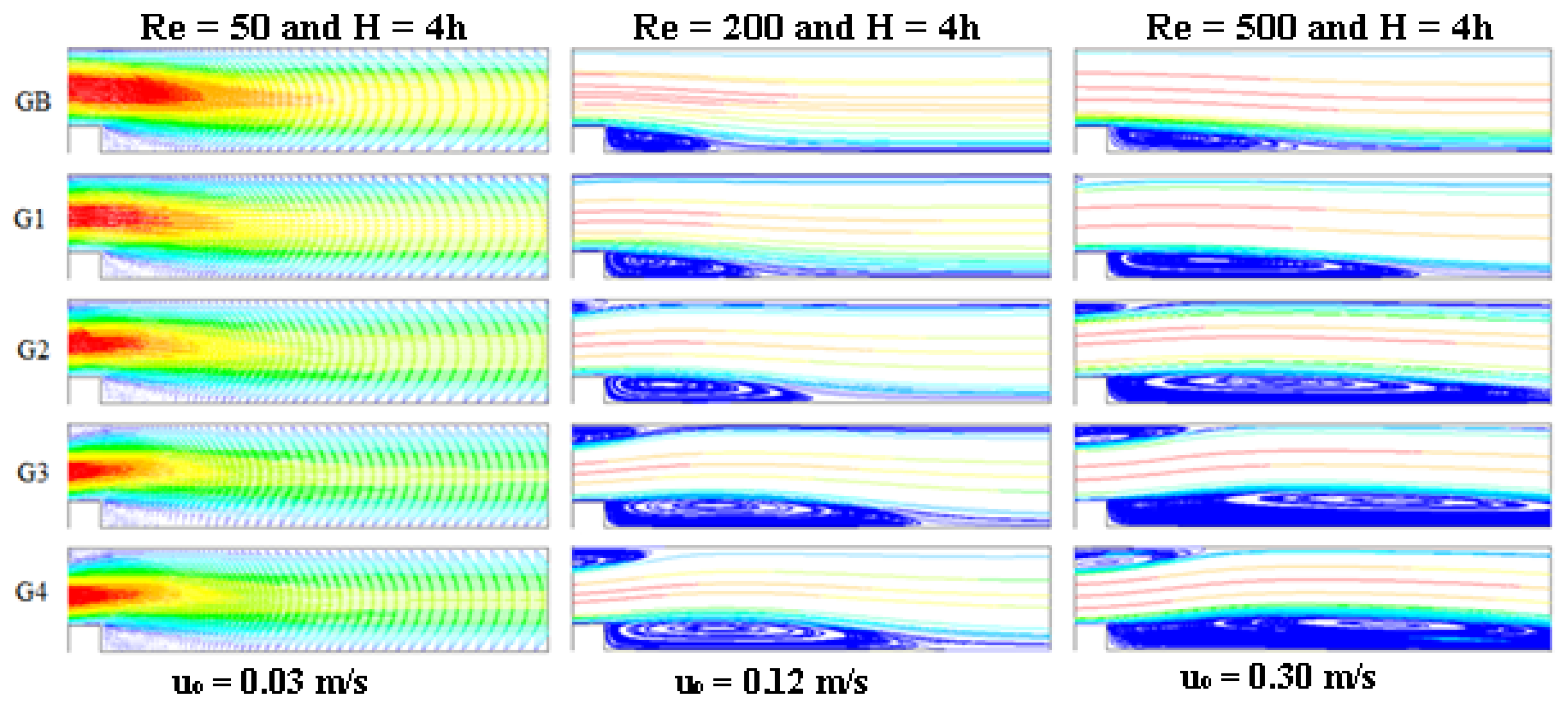
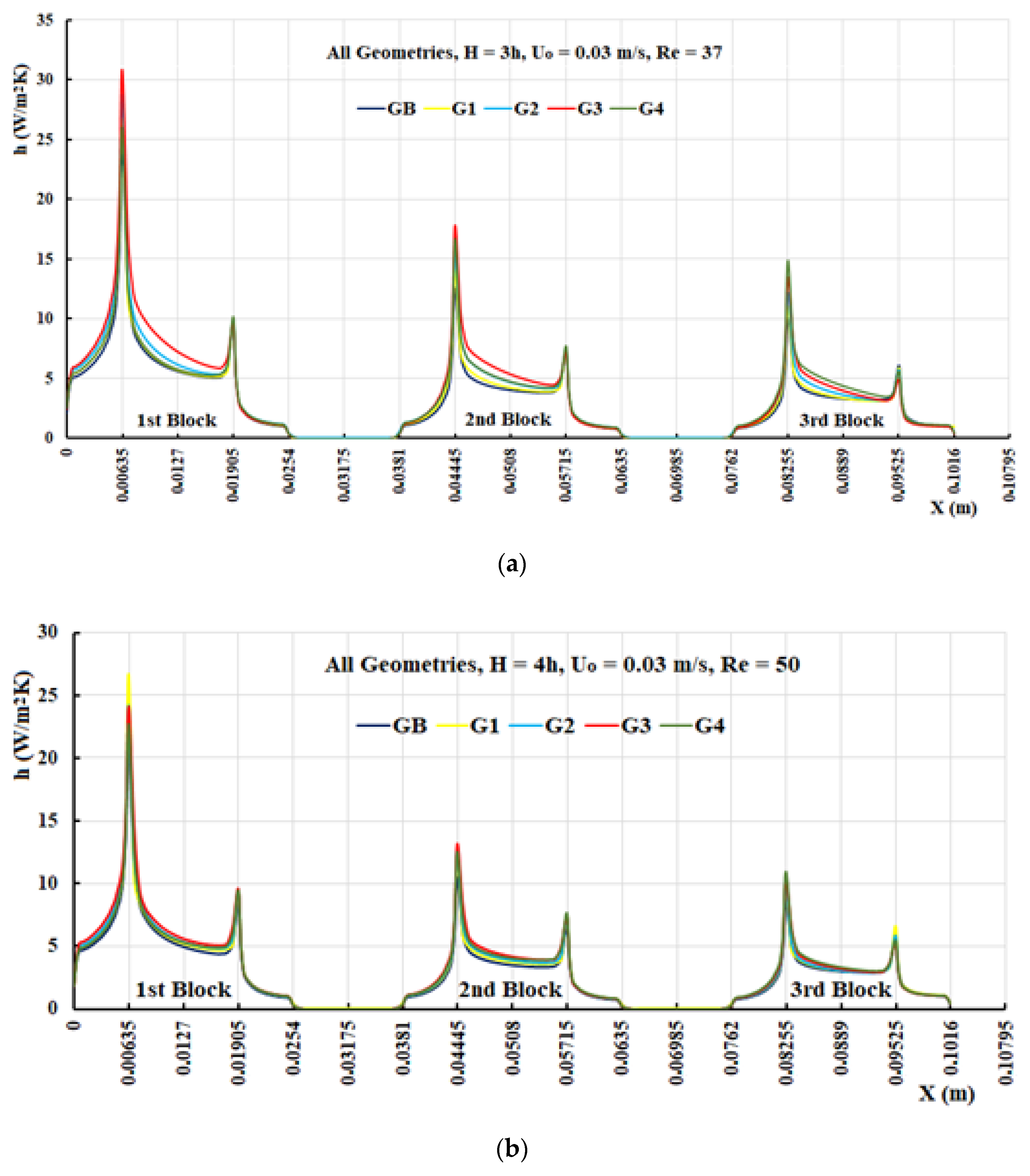
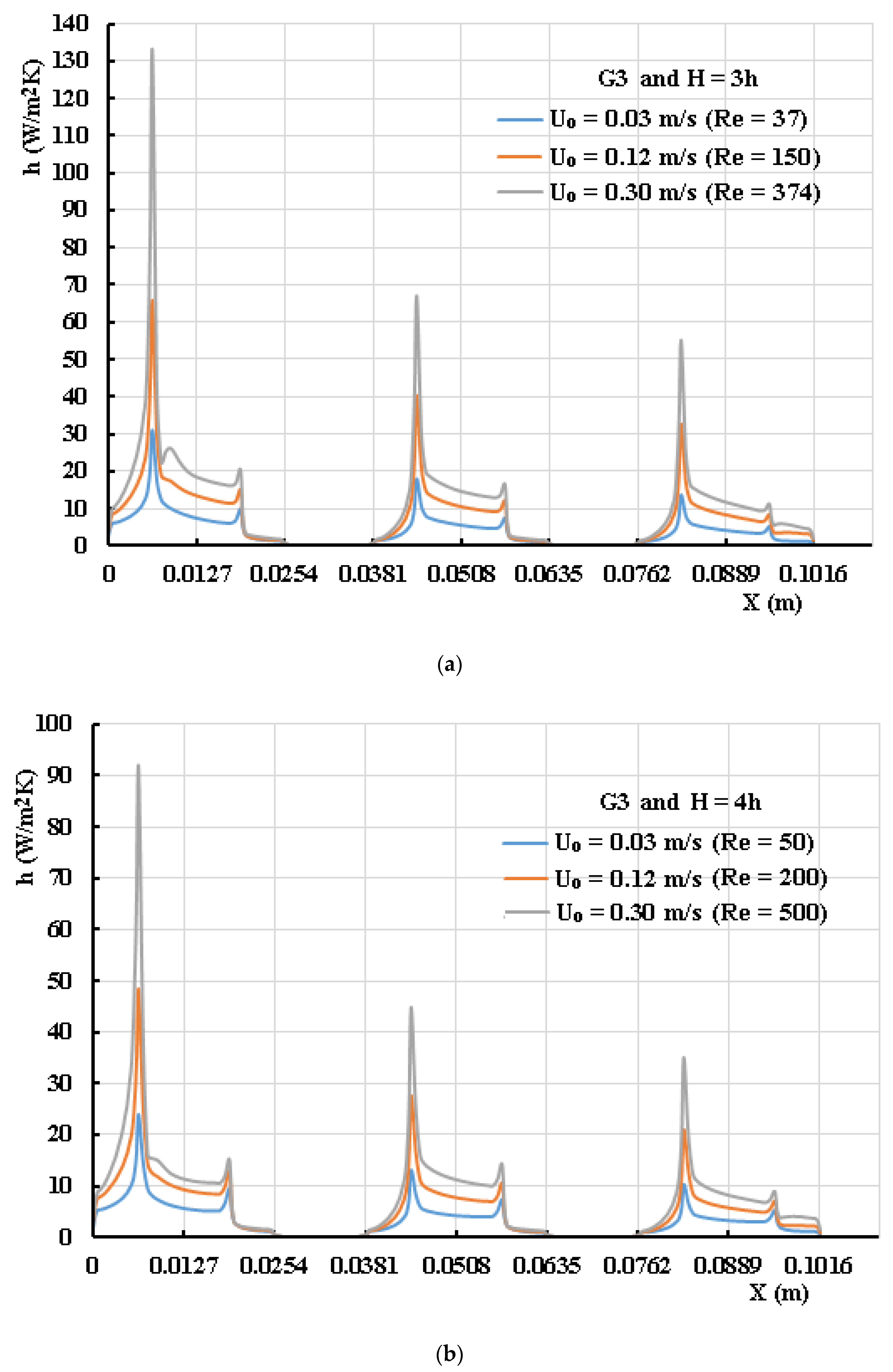
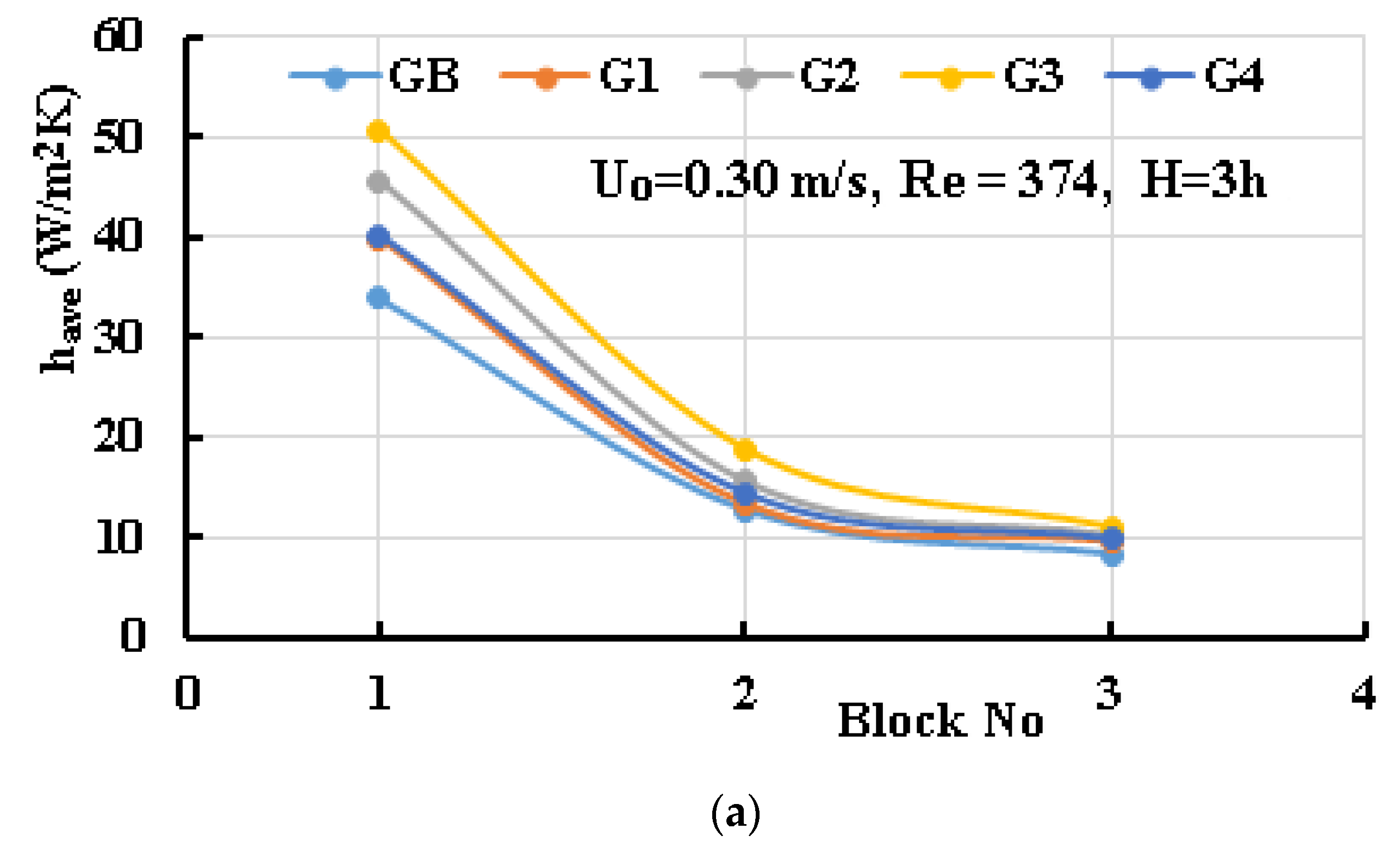
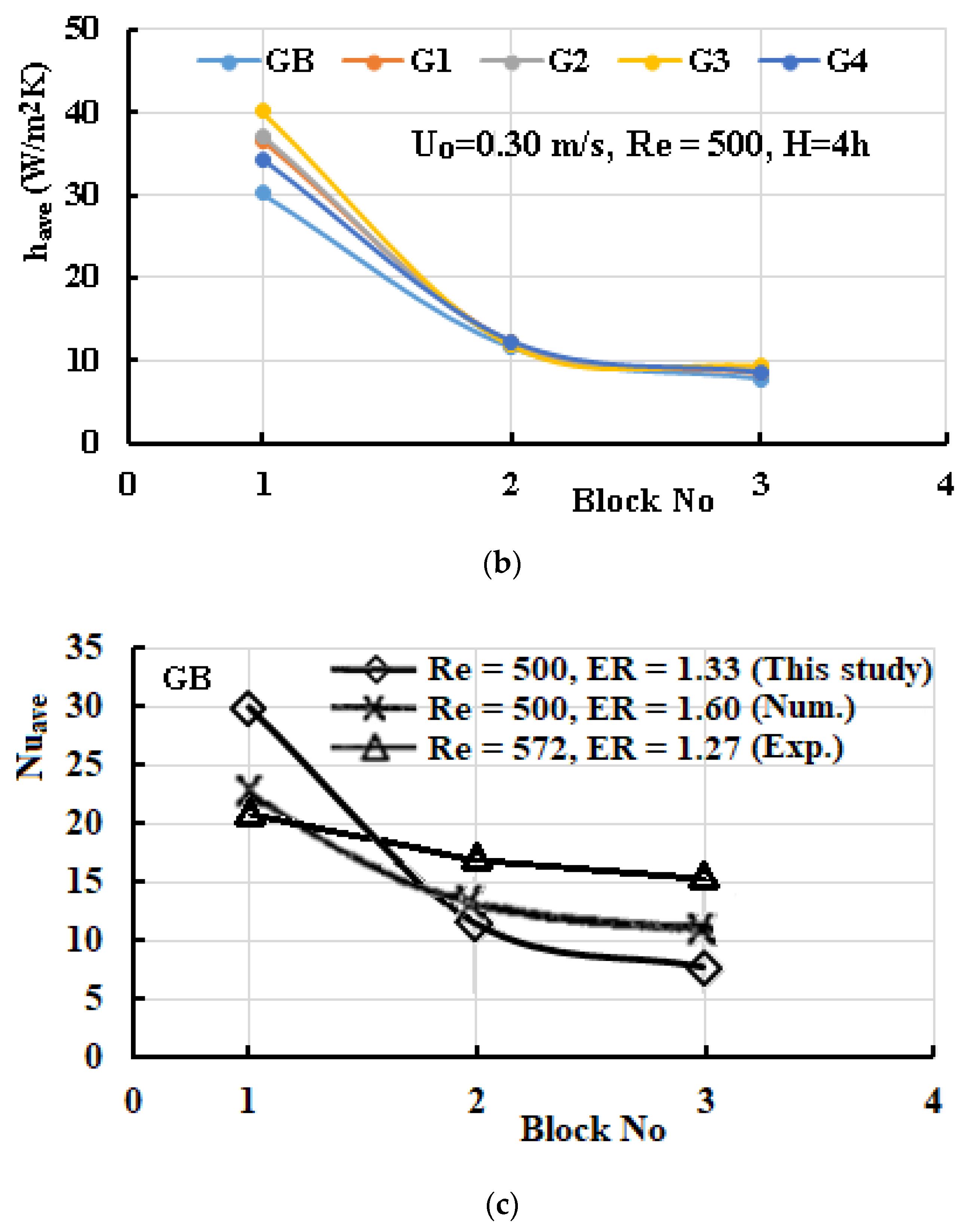
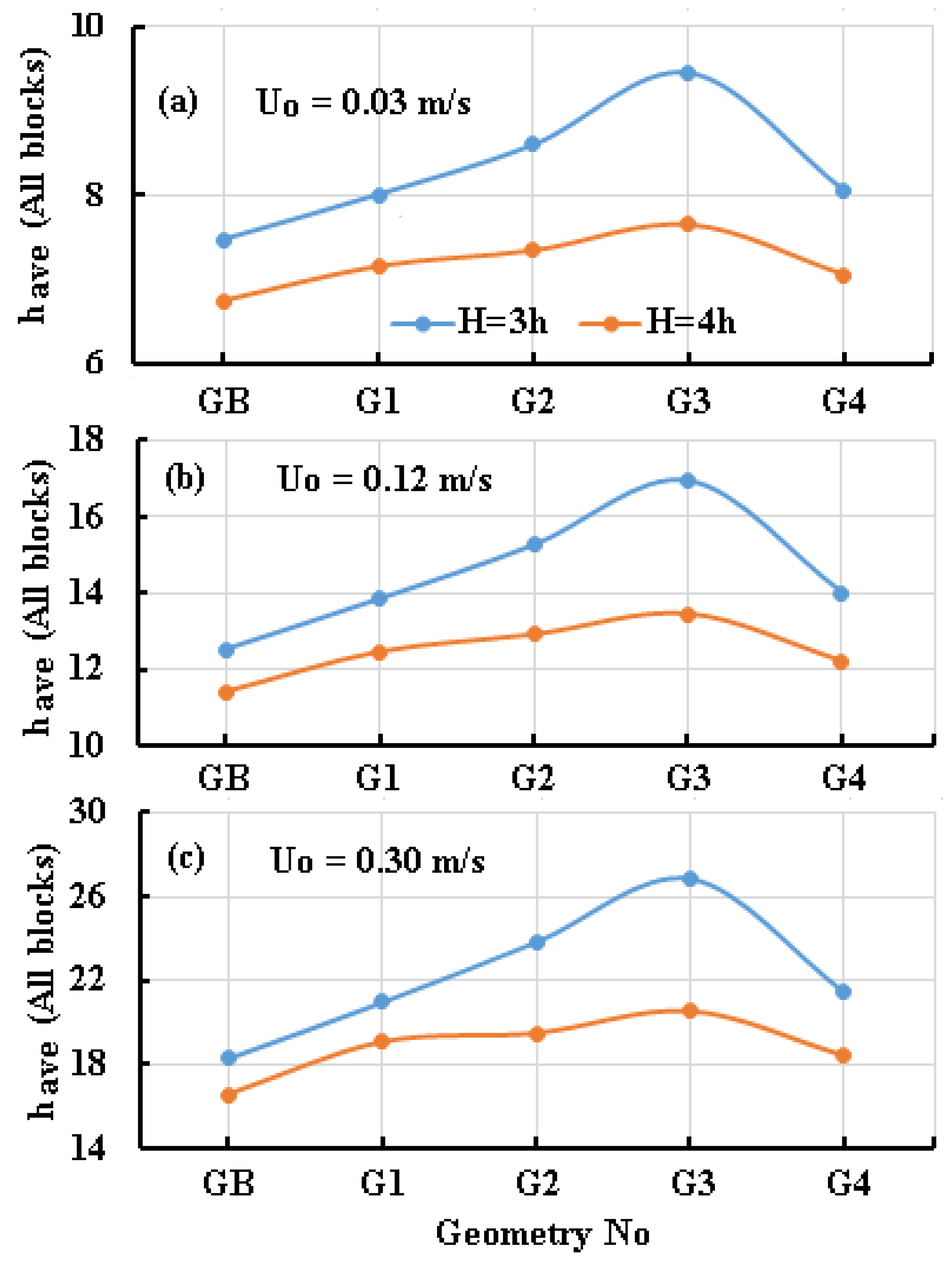
| H = 3 h (This Study) | H = 4 h (This Study) | H = 4 h [37] | H = 4 h [38] | H = 2.67 h [39,40] | H = 4.72 h [41] | |
|---|---|---|---|---|---|---|
| Blockage ratio [h/H] | 0.33 | 0.25 | 0.25 | 0.25 | 0.37 | 0.21 |
| Expansion ratio (ER) [H/(H-h)] | 1.50 | 1.33 | 1.33 | 1.33 | 1.60 | 1.27 |
| Aspect ratio [l/h] | 2.00 | 2.00 | 2.00 | 3.00 | 2.67 | 3.00 |
| Packaging density [s/l] | 1.00 | 1.00 | 1.00 | 1.00 | 0.25 | 1.00 |
| Characteristic Length | ||||||||||
|---|---|---|---|---|---|---|---|---|---|---|
| Inlet Velocity (Uo m/s) | Block Height, h Based Re Number (h = 0.635 cm) | Block Length, l Based Re Number (l = 1.27 cm) | Channel Height, H Based Re Number (Chosen) | Gap Height, H-h Based Re Number | Hydraulic Diameter, Dh = 2 H Based Re Number | |||||
| H = 3 h | H = 4 h | H = 3 h | H = 4 h | H = 3 h | H = 4 h | H = 3 h | H = 4 h | H = 3 h | H = 4 h | |
| 0.03 | 12 | 12 | 25 | 25 | 37 | 50 | 25 | 37 | 75 | 100 |
| 0.12 | 50 | 50 | 100 | 100 | 150 | 200 | 100 | 150 | 300 | 400 |
| 0.30 | 125 | 125 | 250 | 250 | 374 | 500 | 250 | 374 | 750 | 1000 |
| Passage Height | Mesh Structure | Base Geometry GB | First Geometry G1 | Second Geometry G2 | Third Geometry G3 | Fourth Geometry G4 |
|---|---|---|---|---|---|---|
| H = 3 h | Coarse | 2664 | 2997 | 3174 | 2428 | 2648 |
| Medium | 4460 | 5400 | 4658 | 4200 | 4786 | |
| Fine * | 6628 | 8370 | 6588 | 6770 | 7435 | |
| H = 4 h | Coarse | 3564 | 3529 | 4316 | 3543 | 3476 |
| Medium | 5870 | 5882 | 5964 | 5684 | 5320 | |
| Fine * | 8932 | 8469 | 8805 | 8312 | 8696 |
Publisher’s Note: MDPI stays neutral with regard to jurisdictional claims in published maps and institutional affiliations. |
© 2022 by the authors. Licensee MDPI, Basel, Switzerland. This article is an open access article distributed under the terms and conditions of the Creative Commons Attribution (CC BY) license (https://creativecommons.org/licenses/by/4.0/).
Share and Cite
Beyazoglu, E.; Yuce, B.E.; Ates, M.; Yalindag, R.; Sokmen, K.F.; Pulat, E. Cooling of Heated Blocks with Triangular Guide Protrusions Simulating Printed Circuit Boards. Sustainability 2022, 14, 15856. https://doi.org/10.3390/su142315856
Beyazoglu E, Yuce BE, Ates M, Yalindag R, Sokmen KF, Pulat E. Cooling of Heated Blocks with Triangular Guide Protrusions Simulating Printed Circuit Boards. Sustainability. 2022; 14(23):15856. https://doi.org/10.3390/su142315856
Chicago/Turabian StyleBeyazoglu, Ebubekir, Bahadir Erman Yuce, Murat Ates, Rumeysa Yalindag, Kemal Furkan Sokmen, and Erhan Pulat. 2022. "Cooling of Heated Blocks with Triangular Guide Protrusions Simulating Printed Circuit Boards" Sustainability 14, no. 23: 15856. https://doi.org/10.3390/su142315856
APA StyleBeyazoglu, E., Yuce, B. E., Ates, M., Yalindag, R., Sokmen, K. F., & Pulat, E. (2022). Cooling of Heated Blocks with Triangular Guide Protrusions Simulating Printed Circuit Boards. Sustainability, 14(23), 15856. https://doi.org/10.3390/su142315856







